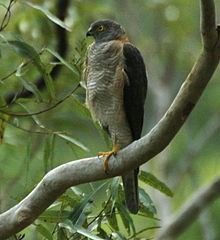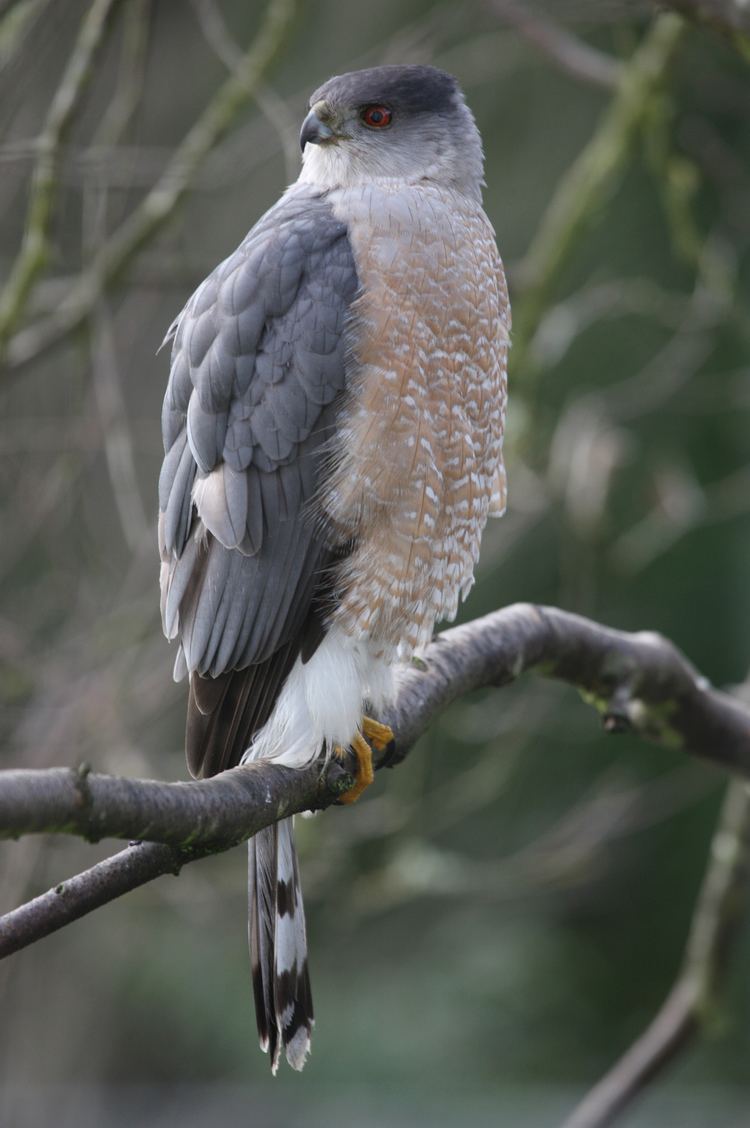Infraclass Neognathae Scientific name Accipiter Phylum Chordata | Subclass Neornithes Superorder Neoaves Rank Genus | |
 | ||
Length Sharp-shinned hawk: 29 – 37 cm, Black sparrowhawk: 40 – 54 cm, Grey goshawk: 40 – 55 cm Lower classifications | ||
Shikra hawk bird accipiter badius
Accipiter is a genus of birds of prey in the family Accipitridae. Most species are called goshawks or sparrowhawks, although all New World species are simply known as hawks. They can be anatomically distinguished from their relatives by the lack of a procoracoid foramen. Two small and aberrant species usually placed here do possess a large procoracoid foramen and are also distinct as regards DNA sequence. They may warrant separation in the old genus Hieraspiza.
Contents
- Shikra hawk bird accipiter badius
- Species in taxonomic order
- Procoracoid foramen
- Genetic phylogeny
- References
Extant accipiters range in size from the little sparrowhawk (A. minullus), in which the smallest males measure 20 cm (7.9 in) long, span 39 cm (15 in) across the wings and weigh 68 g (2.4 oz), to the northern goshawk (A. gentilis), in which the largest females measure 64 cm (25 in) long, span 127 cm (50 in) across the wings, and weigh 2,200 g (4.9 lb). These birds are slender with short, broad, rounded wings and a long tail which helps them maneuver in flight. They have long legs and long, sharp talons used to kill their prey, and a sharp, hooked bill used in feeding. Females tend to be larger than males. They often ambush their prey, mainly small birds and mammals, capturing them after a short chase. The typical flight pattern is a series of flaps followed by a short glide. They are commonly found in wooded or shrubby areas.

The genus Accipiter was introduced by the French zoologist Mathurin Jacques Brisson in 1760. The name is Latin for "hawk", from accipere, "to grasp".
Species in taxonomic order

Extinct species include:
An Accipiter was seen on 12 March 1994 south of the summit of Camiguin in the Philippines, where the genus was not known to occur. It may have been an undescribed taxon, but more likely it was not; it could simply have been a vagrant of a known species.
Procoracoid foramen
The procoracoid foramen (or coracoid foramen, coracoid fenestra) is a hole through the process at the front of the coracoid bone, which accommodates the supracoracoideus nerve. In some groups of birds it may be present as a notch, or incisura; or the notch may be partially or weakly closed with bone. In other groups the feature is completely absent.
The foramen is generally present in birds of prey, but it is absent in most Accipiter hawks that have been studied. This absence is proposed as a diagnostic feature.
A study of accipitrid skeletons found procoracoid incisurae (as opposed to foramina) in some specimens of the eagles Aquila gurneyi and A. chrysaetos, but not in four other Aquila species. The notch was variably open or weakly ossified in Spizastur melanoleucos, Lophoaetus occipitalis, Spizaetus ornatus, and Stephanoaetus coronatus. Also the buteonine hawks Buteo brachyurus and B. hemilasius had incisurae, differing from 17 other Buteo species.
In Circus the foramen was found to be variable, not only within species but even between sides in the same individual. It is usually open or absent but may be closed by "a thread of bone". Research in genetic phylogeny has since indicated that Circus is closely related to Accipiter.
The notch was also absent or indistinct in Harpagus bidentatus.
Urotriorchis macrourus has a well-developed procoracoid foramen, which suggests a separation from Accipiter. It may be related to the chanting goshawks in tribe Melieraxini.
Genetic phylogeny
Analysis of molecular genetics indicates that Accipiter is paraphyletic to the Circus harriers, even though the two groups differ in hunting habits and body shape. There are three or four clades of Accipiter, with Circus, Megatriorchis and Erythrotriorchis intermixed.
John Boyd proposes splitting Accipiter into four separate genera: Aerospiza, Tachyspiza, Accipiter, and Astur. In this scheme Tachyspiza has the most species, and a reduced Accipiter would have only six: Eurasian sparrowhawk (A. nisus, type species), rufous-breasted sparrowhawk (A. rufiventris), sharp-shinned hawk (A. striatus), white-breasted hawk (A. chionogaster), plain-breasted hawk (A. ventralis), rufous-thighed hawk (A. erythronemius).
